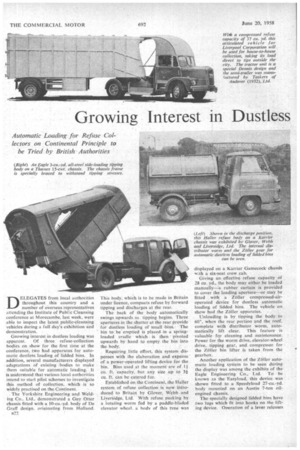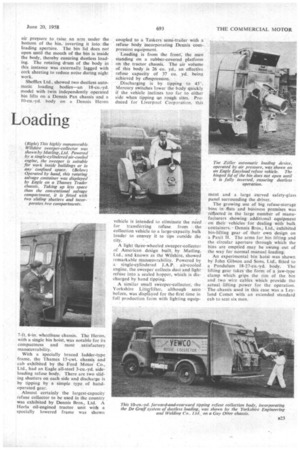Growing Interest in Dustless Loading
Page 56

Page 57

If you've noticed an error in this article please click here to report it so we can fix it.
DELEGATES from local authorities throughout this country and a number of overseas representatives attending the Institute of PubEc Cleansing conference at Morecambe, last week, were able to inspect the latest public-cleansing vehicles during a full day's exhibition and demonstration.
Growing interest in dustless loading was apparent. Of three refuse-collection bodies on show for the first time at the conference, two had apparatus for automatic dustleSs loading of lidded bins. In addition, several manufacturers displayed adaptations of existing . bodies to make them suitable for automatic loading. It is understood that various local authorities intend to start pilot schemes to investigate this method of collection, which is so widely practised on the Continent.
The Yorkshire Engineering and Welding Co.. Ltd.. demonstrated a Guy Otter chassis fitted with a 10-cu.-yd. body of De Graff design. orieinating from Holland.
1522 This body, which is to be made in Britain under licence, compacts refuse by forward tipping and discharges at the rear.
The back of the body automatically swings upwards as tipping begins. Three apertures in the shutter at the rear provide for dustless loading of small .bins. The bin to be emptied is placed in a springloaded cradle which is then • pivoted upwards by hand to empty the bin into the body.
Requiring little effort, this system dispenses with the elaboration and expense of a power-operated lifting device for the bin. Bins used at the moment are of 11 Cu. ft. capacity, but any size up to 31 Cu. ft. can be catered for.
Established on the Continent, the Haller system of refuse collection is now introduced to Britain by Glover. Webb and Liversidge, Ltd. With refuse packing by a rotating worm fed by a paddle-bladed elevator wheel, a body of this tvne was displayed on a Karrier Gamecock chassis w.:th a six-seat crew cab.
Giving an effective refuse capacity of 28 cu. yd., the body may either be loaded manually—a rubber curtain is provided to cover the loading aperture—or may be fitted with a Zoller compressed-airopera ted device for dustless automatic. loading of lidded bins. The vehicle on show had the Zoller apparatus.
Unloading is by tipping the body to 60°. when the rear portion and the roof, complete with distributor worm, automatically lift clear. This feature is valuable for cleaning and maintenance. Power for the worm drive, elevator-wheel drive, tipping gear, and compressor for the Zoller bin lifter is taken from the gearbox.
Another application of the Zoller automatic loading system to be seen during the display was among the exhibits of the Eagle Engineering Co., Ltd. To be known as the Easyload, this device was shown fitted to a Speedyload 27-cu.-yd. body mounted on an Austin 7-ton oilengined chassis.
The specially designed lidded bins have two lugs which fit into hooks on the lifting device. Operation of a lever releases
air prqsure to raise an arm under the bottom of the bin; inverting it into, the loading aperture. The bin lid does not open until the mouth of the bin is inside the body, thereby ensuring dustless loading. The rotating drum of the body in this instance was externally, lagged with cork sheeting to reduce noise during night work.
Shefflex Ltd., showed two dustless automatic loading bodies—an 18-cu.-yd. model with twin independently operated bin lifts on a Dennis Fax chassis and a 10-cu.-yd. body on a Dennis Heron 7-ft. 6-in, wheelbase chassis. The Heron, with a single bin hoist, was notable for its compactness and most satisfactory manceuvrability.
With a specially braced ladder-type frame, the Thames 15-cwt. chassis and cab exhibited by the Ford Motor Co., Ltd.. had an Eagle all-steel 3-cu.-yd. sideloading refuse body. There are two sliding shutters on each side and discharge is by tipping by a simple type of handoperated gear.
Almost certainly the largest-capacity refuse collector to be used in the country was exhibited by Dennis Bros., Ltd. A Horla oil-engined tractor unit with a specially lowered frame was shown coupled to a Takers semi-trailer with a refuse body incorporating Dennis compression equipment.
Loading is from the front, the men standing on a rubber-covered platform on the tractor chassis. The air volume of this body is 26 cu. yd., an effective refuse capacity of 37 cu. yd. being achieved by compression.
Discharging is by tipping to 45. Mercury switches lower the body quickly if the vehicle inclines too far to either side when tipping an rough sites. Produced for Liverpool Corporation, this vehicle is intended to eliminate the need for transferring refuse from the collection vehicle to a large-capacity,bulk loader to convey it to tips outside the city.
A light three-wheeled sweeper-collector or American design built, by Matling, Ltd., and known as the Wilshire, showed remarkable manceuvrability. Powered by a single-cylindered T.A.P. air-cooled engine, the sweeper collects dust and light refuse into a sealed hopper, which is discharged by hand tipping.
A similar small sweeper-collector, the Yorkshire Littglifter, although seen before, was displayed for the -first time in full production form with lighting equip meat and a large curved safety-glass panel surrounding the driver.
The growing use of big refuse-storage 'bins in flats and business premises was reflected in the large number or manufacturers showing additional equipment on their vehicles for dealing with bulk containers. Dennis Bros., Ltd., exhibited bin-lifting gear of their own design on a Paxit IL The arms for bin lifting and the circular aperture through which the bins are emptied may be swung out of the way for normal manual loading.
An experimental bin hoist was shown by John Gibson and Sons, Ltd:, fitted to a Pendulum 18-27-cu.-yd. body. The lifting gear takes the form of a jaw-type clamp which grips the rim of the bin and two wire cables which provide the actual lifting power for the operation. Thechassis used in this case was a Leyland Comet with an extended standard cab to seat six men,




































































































